Showcasing Black artists at The Rose Art Museum
The museum's curatorial team is dedicated to amplifying diverse and marginalized voices as a form of radical storytelling.
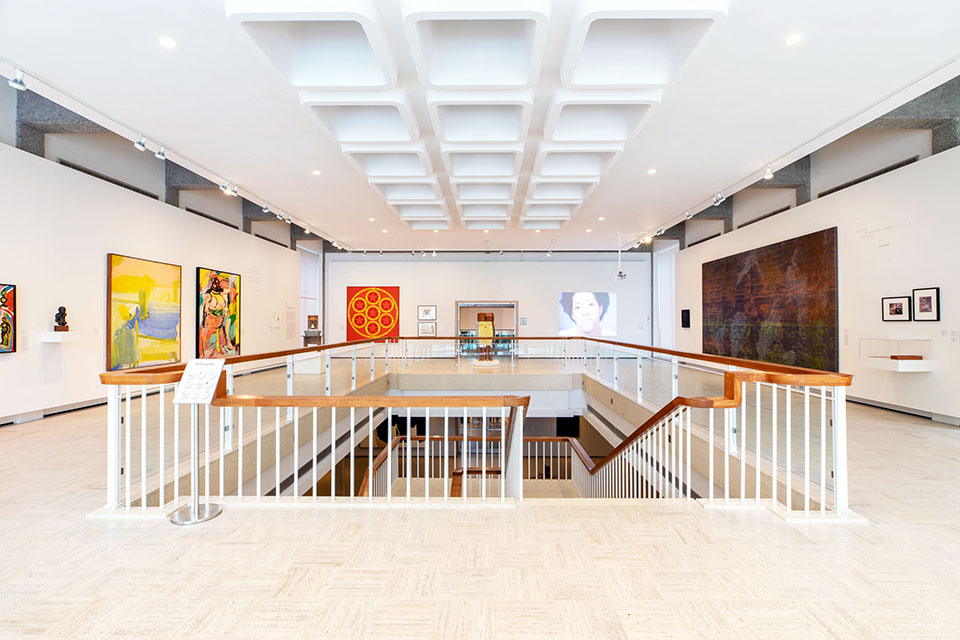
Installation view, re: collections, Six Decades at the Rose Art Museum, Rose Art Museum, Brandeis University, June 25, 2021–June 2, 2024. Photo by Mel Taing. Courtesy Rose Art Museum.
The Rose Art Museum’s current exhibition, re: collections, Six Decades at the Rose Art Museum places artworks by historically underrepresented artists on equal footing with well-known and iconic pieces. On display until 2024, with several planned rotations, activations and interventions, the show amplifies diverse and marginalized voices as a form of radical storytelling.
Gannit Ankori, Henry and Lois Foster Director and Chief Curator and Brandeis Professor of Fine Arts and Women's, Gender and Sexuality Studies, worked alongside Caitlin Julia Rubin, Associate Curator and Director of Programs, and Dr. Elyan Jeanine Hill, the Rose’s Guest Curator of Africa and African Diaspora Art, to select a broad range of artists for inclusion in the exhibition. The curatorial team selected works from the Rose’s permanent collection that provided a broader understanding of art histories and socio-political histories, highlighting narratives presented by Black artists. Each piece offers a different perspective, with many works connecting to a larger shared message.
The history of art has often been told from a narrow-euro-centric (mostly white male) perspective. Ankori, Hill and Rubin wanted to shake up the familiar narratives. “We wanted to explore and amplify a more complex, inclusive, and multi-vocal story,” Ankori said. “When we think about growing the Rose collection, we are thankful and appreciate the great canonical pieces we have, but we must also consider what we lack: the gaps and lacunae in our holdings. The team and I are committed to ensuring that artists who had been overlooked, marginalized, or invisibilized in the past, will have a central place at the Rose. We have expanded our collection to include diverse artists, and we mount exhibitions that listen to previously silenced voices as they tell new powerful stories of art, society and the human condition.”
The artists highlighted below create art in different mediums, but share the same passion: reclaiming the narrative of African and African diasporic histories.
Embracing Controversy
As visitors enter the Rose Art Museum, they are greeted by an alarming sight: numerous depictions of the mammy figure—a racist stereotypical trope in American visual history used to depict Black domestics, who often cared for white families, the most famous mammy being Aunt Jemima. These controversial images are (or, at least, should be) upsetting to a modern audience; however, the works featured in the museum aim to reclaim this narrative.
“We deliberated long and hard before we decided to include these images,” said Ankori. “As a curatorial team we didn’t want to display offensive images that have the potential to do harm. But we also did not want to censor art or bury a motif that is so entrenched in American pop culture. Much like the artists whose work is on view, we wanted to challenge our visitors and Brandeis students to face racism and its stereotypes. This prompts provocative and difficult conversations, in dialogue with contemporary artists, that confront this deep and troubled past and present.”
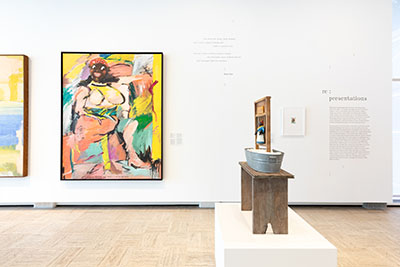
I Gets a Thrill When I See De Koo (1978) Installation view, re: collections, Six Decades at the Rose Art Museum, Rose Art Museum, Brandeis University, June 25, 2021–June 2, 2024. Photo by Mel Taing. Courtesy Rose Art Museum.
Works with an overarching theme are grouped throughout the museum. The pieces that depict a mammy figure are displayed together on the first floor.
Robert Colescott’s I Gets a Thrill When I See De Koo (1978) is hung in dialogue with Willem de Kooning’s Untitled (1961). The two works placed together reinforce Colescott’s direct reference to de Kooning’s iconic style of painting, and de Kooning’s monstrous depictions of women. Colescott goes a step further, by transforming de Kooning’s nude woman into a mammy. With I Gets a Thrill When I See De Koo, Colescott melds subversive humor and art historical irreverence to interrogate and address the racism and sexism embedded in American society.
This painting can be disturbing to contemporary audiences, but challenges the viewer to think about commonplace harmful and stereotypical cultural images that are only now being examined in broader society...
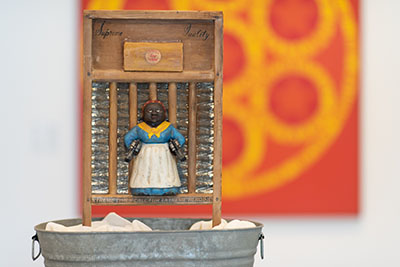
Supreme Quality (1998) Installation view, re: collections, Six Decades at the Rose Art Museum, Rose Art Museum, Brandeis University, June 25, 2021–June 2, 2024. Photo by Mel Taing. Courtesy Rose Art Museum.
Grouped next to Colescott’s painting are two additional works that employ the mammy figure. One by Andy Warhol and a second by Betye Saar. Warhol’s Mammy (Sylvia Williams) (1981) shows an image of a Black woman posing as a stereotypical mammy. Warhol’s use of the mammy trope erases the sitter’s identity, she becomes the stereotype. while Saar’s piece, Supreme Quality (1998) transforms the mammy into a heroine of Black liberation. Saar’s piece features a mammy figurine armed with guns, with the words “Extreme Times Call for Extreme Heroines” prominently featured above. By doing this, Saar reclaims the narrative of the mammy, making her a heroine to fight the forces of white terrorism. Her ideas behind the work are displayed nearby on the museum wall.
“The reason for using [Aunt Jemima] was to take a negative image and make it a positive one. I set out to take all these negative images that had been a part of Black history, and I changed them into warriors,” said Betsy Saar on her works.
Additional work by Saar can be found in the museum’s Lower Rose Gallery, which also interrogates the history and labor of Black domestics in the United States.
Reclaiming Power
The museum’s Lower Rose Gallery features a section depicting multiple Black women with children. These pieces evoke the Madonna and Child motif frequently seen throughout Western art. The artists featured in re: collections, recast the standard white mother and child of history by illustrating motherhood through the perspective of Black women. A quote from each artist on display allows audiences to connect deeper with their stories. “We chose these pieces because we wanted to retell this well-known motif through the experience of Black women,” said Ankori. “There are so many narratives to be shared.”
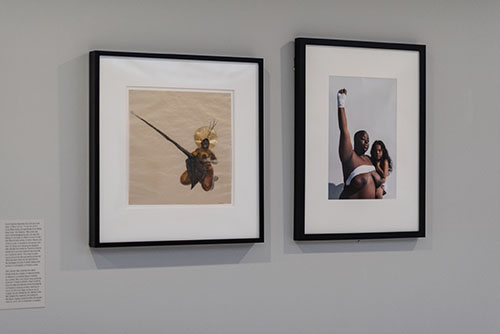
Warrior and Child (2012) Installation view, re: collections, Six Decades at the Rose Art Museum, Rose Art Museum, Brandeis University, June 25, 2021–June 2, 2024. Photo by Isometric Studio. Courtesy Rose Art Museum.
Warrior and Child (2012) by Nona Faustine serves as a ‘love letter’ to Black women. Faustine presents herself holding her child in a strong stance, depicting herself as a powerful warrior. “I knew the power of the Black body, and specifically of my fleshy, large body,” she explains. “[My work] was about acknowledging the pain, but also the beauty of my body, of a Black woman’s body.”
Nearby stands the towering self-portrait, Yo Mama (1993), by Renee Cox holding her child in another reconfiguration of the Madonna and Child. She poses nude, holding her child horizontally in this larger than life Gelatin Silver Photograph. “I refuse to be put down, squashed, or made invisible. I’m here, seven feet tall, larger than life.”
Rediscovering Identities
Several artists use their medium to redefine the narrative. They produce their pieces to express their art, but to also share their perspective.
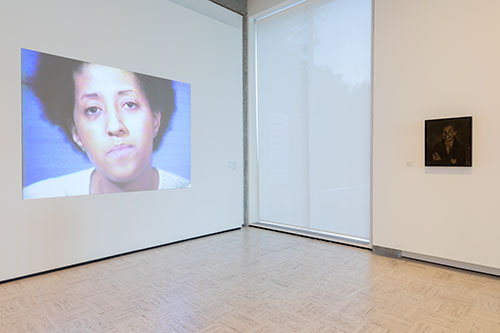
Free, White, and 21 (1980) Installation view, re: collections, Six Decades at the Rose Art Museum, Rose Art Museum, Brandeis University, June 25, 2021–June 2, 2024. Photo by Mel Taing. Courtesy Rose Art Museum.
Howardena Pindell’s video is on display in the Fineberg Gallery, but her powerful voice echoes throughout the Lower gallery of the museum. Her piece, Free, White, and 21 (1980), alternately voices Pindell’s own experiences with prejudice, and performing the role of a privileged white woman, who dismisses these lived experiences and the pain they inflicted. Her quote, featured on the museum wall, highlights her perspective.
“I decided to make Free, White and 21 after yet another run-in with racism in the art world and the white feminists.... It was about domination and the erasure of experience, canceling and rewriting history in a way that made one group feel safe and not threatened."
Ankori and her team select emotional and powerful artworks because of their deep significance. “I don’t view art as ‘entertainment’ or a ‘frill’,” said Ankori. “Art is an essential human activity, a way to reflect upon, resist, or reimagine reality. It is a medium through which those who create art, and experience art, make sense of the world."
Categories: Arts, General, Humanities and Social Sciences





